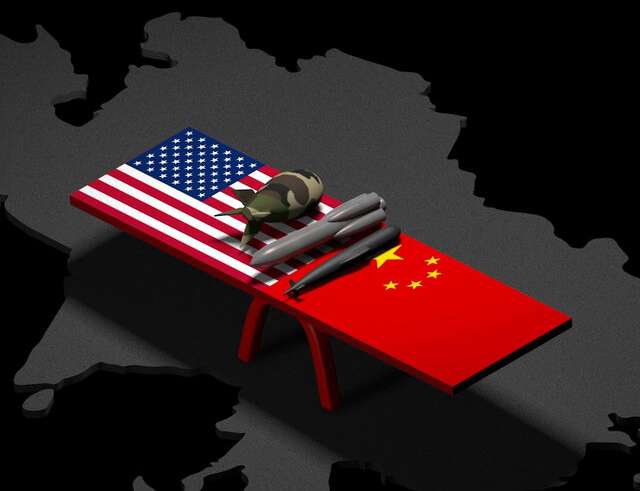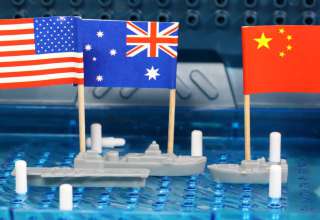By Brian Boyd, July 2023
This is the second of a three part-series that examines the strategic reasons for the AUKUS pact and the dangers for Australia.
SILENCE
With the growing global tensions, the Australian government is, so far, remaining silent on what is the actual existential military threat facing our nation.
For some years a bevy of pro-US war hawk propagandists and so-called security experts, have continually pointed the finger at China, asserting that its military build – up and economic activities in our region, justifies predicting that war between the US and China will occur. They only differ on the timeline! No details of the nature of what constitutes the threat, are ever given. This repetitive, but non-defined ‘threat’ narrative is regularly published,, despite the tacit admission by these same right – wing think tanks that China has neither the capability, nor the intention’ to undertake any kind of military invasion of Australia.
Recent figures from the International Peace Research Institute in Stockholm show that for 2022 alone, the US accounted for 39% of global military expenditure, China was second at 13%, as was the European Union with 13%, followed by Russia at 4%, India at 3.6%, Saudia Arabia at 3.3% and Britain at 3%.
Within this global arms race Australians are being told an updated and expanded defence framework for Australia’s Armed Forces, will require an increase in the existing 2% of GDP on military expenditure. But when the unclassified parts of the defence strategic review were released on Anzac Day in April, there were no budgetary increases announced.
Many of the pro—war hawks, who had been praising the Albanese/Marles AUKUS hype for months, now openly criticise the government for not putting the required monetary expenditures against the announced acquisition of new, high-tech military assets. One hawk said he was “underwhelmed”, adding “there was no coherent plan for what the army should be doing”.
If Australia is “going to redesign the [Australian] Defence Force… [to make]… It ‘fit for purpose’ in the riskiest strategic environment since the end of World War II…[then why has the aim]… been mugged by budget reality?”
Another hawk bluntly stated that the Defence Strategic Review (DSR) was now “worthless” and “extremely disappointing”, given “we will not spend a single dollar more on defence than what has been planned for years and years”, especially since “the region has seen the return of major power strategic competition, the intensity of which should be seen as the defining feature of our region and time”. He added bluntly: “… there was nothing in it [the DSR] that would cause any Beijing military planner a nano-second of concern”.
In a small article entitled:’ Defence funds fall short of rhetoric’ (Australian 30/5/23), it is revealed that “new analysis” of the Federal May budget actually “reduced Defence’s core funding by $1.5 billion! The article noted that the only increase of $4 billion was compensation for the fall in the value of the Australian dollar. At best the defence budget was described as being in a “holding pattern”. More interestingly the article said the analysis flew in the face of “the Federal government’s warnings of unprecedented strategic circumstances” and quoted the ASPI that there was quite a “significant gap” between the Defence Strategic Review rhetoric and the 2023-24 Defence budget.
Surely it is fair to suggest that the Australian government, in order to keep its current defence spending trajectory over forward estimates, fails to reflect the claimed ‘threat urgency’ that the Australian public has being hearing for a number of years.
One pro-US war hawk, a senior national security figure during the Morrison/Dutton years, who made headlines, claiming the “drums of war” are beating in the Indo-Pacific, has suddenly changed his tune. He went public again in mid-May, warning world leaders not to yield to “war fever” and to learn the lessons of the past “in an era of nuclear weapons”!
Home affairs department secretary Michael Pezzullo went further suggesting “we are all bound in a sacred duty to do whatever we can to prevent war”. Amazing.
WHAT DO THEY KNOW, THAT WE DON’T
The Australian public has been repeatedly told that the strategic situation facing Australia in the Indo-Pacific is becoming increasingly “dire” by the day and requires a more up-to-date, well – armed and focused defence Force. Yet the claimed urgency of the situation will only see the arrival of new stockpiles of long-range missiles, artillery shells and sea mines, years away. Never mind the first of our proposed nuclear powered submarines is possible within 10 years.
What is the government not telling us?
The ADF will no longer concentrate on defending the continent from any potential aggressor, but will shift to a ‘forward defence posture’, code for fighting far from home. If China, or any other nation state, has offensive intent against Australia, the public is entitled to be informed. Both the Morrison and Albanese governments have never explained the strategic assessment underpinning AUKUS and the Defence Strategic Review.
The Albanese government could, through the Sino-Australian Ministry of National Defence working meetings (one was held last March in Australia), seek from the Chinese: Are there any issues that could lead to the Chinese invading or launching military attacks on our country? It is incumbent on China “to demonstrate that its military buildup is defensive in nature, not aggressive”.
It was reported that the recent bilateral meeting “was conducted in a professional atmosphere with both sides exchanging views on regional security issues”. The US conducts such discussions with China regularly, despite the tensions. The Australian public deserve transparency concerning such deliberations.
Back in early March Prime Minister Anthony Albanese said he was willing to travel to meet China’s leader Xi Jinping, saying: “We want a more stable, secure region… we will cooperate with China where we can, disagree where we must, but we will engage in our national interest”. He added: “It is in Australia’s interests to export to China, but it is in China’s interest to receive the magnificent products we produce here in Australia as well.”
The Prime Minister also said: “The world has changed… we don’t seek conflict with any nation”, adding the rider that China has become “much more forward leaning” in the Indo- Pacific and that his government is acting on “what we see as the facts before us”.
But what are the “facts” that will show there is hostile military aggression being considered against Australia?
There is no recognition in the PM’s statements about regular media commentary claiming- “brinkmanship by great powers is becoming more commonplace” and its potential impact on Australia. Why? This was an opportunity for PM Albanese to explain the underpinning assumptions behind the initial $300 billion plus submarine proposal, and for Australia to spend more billions of dollars on other AUKUS defence procurements.
THE ‘NEW’ SUBMARINES – AN INSULT
The media reportage surrounding the proposed supply of nuclear powered submarines to Australia has basically been an exercise in political theatre, lacking any realistic detail and is quite frankly, insulting. The vast majority of the Australian media displayed “acquiescence” to the AUKUS submarine announcement.
An interesting example of this lack of critical analysis by the Australian media is the following:
Australians learn, nearly 2 years after the initial Morrison era AUKUS announcement, that President Joe Biden insisted Australia buy US rather than British-design submarines, “as a condition of US support for the AUKUS security pact”! In addition we also learn that the US chose September 15, 2021 for the announcement of the AUKUS pact, to “distract attention from its withdrawal from Afghanistan weeks earlier”. These revelations emerged after a media report revealed former Australian Prime Minister Scott Morrison had volunteered them in an interview for a forthcoming book.
It should also be recalled that back in 2022 Kurt Campbell, White House aide on Indo-Pacific affairs, told EU officials that AUKUS “gets Australia off the fence and locks it in for the next 40 years”.
Recently, media commentator James Curran (6/7/23) said that this view from a senior US official about Australia, needed to be questioned.
Curran said that in effect, this attitude is suggesting “that unless an ally is totally in line with Washington on policy, its alliance credentials are to be questioned… allies need to sing as full-throatedly as possible from the American song sheet”.
Kurt Campbell addressed a public seminar on the strategic and military implications of AUKUS in Washington in the last week of June this year. On the question of US nuclear powered submarines being supplied to Australia he commented: “when submarines are provided from the US to Australia, it’s not like they’re lost. They will just be deployed by the closest possible allied force”. This comment challenges the Albanese government’s public insistence that Australia will always be in “full sovereign control” over its nuclear-powered submarines. The Australian government needs to explain how the new submarines will be used, especially if war breaks out.
Of more serious concern is the report, without government challenge, that by the time the proposed eight US and hybrid submarines are delivered and become “Australian flagged”, they will be “nearing obsolescence”. Delivery of the full complement of eight submarines is projected to be by the 2050s and beyond.
Regardless, the vote in the US Congress to approve the sale of the nuclear powered submarines to Australia, is still yet to occur. It is reported that this should happen before the next US presidential election due in November 2024! To date the Australian public have been served up the submarine sale as a fait accompli.
On 27 June 2023 a US Admiral told a seminar in Washington that it was an “aspirational” aim of the US Navy to meet the production targets needed to ensure Australia was able to purchase up to 5 nuclear-powered Virginia-class submarines as promised under AUKUS! The Admiral added it was “too early to say precisely where those submarines will come from”.
The Australian media have given little coverage to the many export controls on sensitive US military equipment. These tough US laws are designed to prevent the proliferation of US weapon technologies and systems around the world and are currently impacting on implementing much of the AUKUS announcements.
Since the AUKUS announcement Australian government ministers have been going cap in hand to Washington with angst being expressed about why these barriers have not been cut through by the Biden administration already. US officials have revealed that the export controls holding up US military hardware earmarked to go to Australia could have been done “…quickly by the Biden administration without having to pass through Congress”. One US official is quoted as saying: Biden “could easily do it; I don’t know why they haven’t done it already. They did it for Ukraine in a matter of weeks.”
One media report in early June pointed out: “Australia will have a capability gap of 10 years without any submarines unless the U.S. Congress swiftly passes legislation authorising the transfer of Virginia-class submarines promised under AUKUS”.
This “technology collaboration” requires multiple pieces of US legislation. Ironically one of the pieces of legislation is needed to “facilitate” the $3 billion contribution Australia is making to strengthen America’s submarine production lines, as part of the AUKUS pact!
To add insult to injury the Australian Senate by late June has ask a Senate committee to examine the Albanese government’s military posture amid concerns it could sideline domestic manufacturers. The “much-hyped” DSR is now being described as “vague and underfunded” and could advantage offshore competitors rather than local Australian defence companies. Again so much for the promise of tens of thousands of Australian jobs that AUKUS is supposed to produce.
In June former Australian defence Minister Kim Beazley made a speech at an ASPI forum warning that Australia is embarrassingly dependent on America for a national security. He said successive Australian governments had “dropped the ball” on defence spending, adding; “we are totally dependent on the US, it’s a bit embarrassing to have to concede that”.
The first of 3 to 5 US submarines will be existing “pre-owned”, second-hand boats, not newly built. One US Congressman found it necessary to go public and promise they “won’t be clunkers”! Further it is revealed, if Australia has three submarines in hand initially, only one can be deployed at any one time and even with five, Australia will only be able to manage on average of “one and a bit” on mission at any one time.
One commentator revealed: “The acoustic signature of the [existing US] Virginia-class [submarines] is known to China”, already. Buried in another commentator’s article is the revelation that satellite and drone surveillance is already compromising diesel-electric submarines (ie Collin class submarines currently used by Australia), because they are required to surface to recharge batteries during the transit. These are the same submarines that are nominated to fill the so-called ‘capability gap’ until the first US submarines arrive.
This signature reading capability is already evolving to extend to the stealth capability of Australia’s proposed nuclear powered submarine fleet ‘on order’. This is not acknowledged by the government’s Defence Minister. In May 2020 researchers at the National Security College at the Australian National University published a report that new detection technologies, based on Artificial Intelligence (AI], could compromise this most secure element ( ie stealth) of modern submarines. Similarly in July 2022 in the ‘IEEE Spectrum’, the journal of the International Institute of Electrical and Electronic Engineers, an article entitled: ‘Will AI steal submarine’s stealth?’, strongly suggested that “better detection will make the oceans transparent”.
Both reports stated that the spectre of transparent oceans could eventuate much earlier than the 2050s’, which would eclipse the timeframe when Australia has its full complement of the proposed ‘new’ submarine fleet. The potential specific impacts of AI on Australia’s new military hardware is not addressed in the unclassified DSR.
Other commentary reveals that the Prime Minister’s insistence Australia will maintain “100% sovereignty” over the nuclear powered submarines may look good “…on paper, but it is unlikely to be the reality… because of the submarines extreme complexity, Australia won’t be able to operate them on its own. It may even have to let the US borrow them under the new “interchangeability” and “interoperability” policy announced by defence Minister Richard Marles”.
How some of these commentators know about such matters is never explained. And, more importantly, the government never comments.
Adding insult to injury, the AUKUS deal has Australia initially tied into investing billions of Australian dollars in expanding US shipbuilding yards. This is to help lift the construction output of the US’s new, more advanced Virginia class submarine and the even more modern Columbia class submarine. All this in order to help the U.S. Navy “fill the void left from selling existing Virginia class submarines to Australia”!
And while Australian Prime Minister Albanese was in India, the US president and the British Prime Minister went public, before the official launch of AUKUS, to brag that they had secured “a slice of Australia’s billions” to generate thousands of jobs in their own countries. The Australian Prime Minister was clearly blindsided. The Australian government’s claim that the AUKUS submarines “will generate 20,000 jobs in defence”, is surely on the never-never.
The ‘taking-for-granted’ attitude towards Australia, was again on display during the recent US debt crisis of May-June. For weeks PM Albanese had made much of US president Biden’s planned visit to Australia and PNG. Biden called off the visit at the last minute, claiming the debt crisis back in the US was demanding his presence. Yet Biden had time to go to Japan for a G7 summit. Newspapers had headlines like: ‘Biden’s no-show snub to friend…’and ‘Biden ditches us…’.
Three days at the G7 was crucial to the US in keeping them ‘in the tent’ as part of its global campaign to contain China. One editorial commented: “[Biden’s] decision not to visit Australia also provides weight to the arguments that arrangements like AUKUS and the Quad are at the mercy of the US… and not treated with due seriousness by the most influential member…’.
THE REAL AGENDA OF AUKUS
The nuclear powered submarine announcement (Pillar 1) has been described as a “half-truth” that “conceals the bigger truth”. AUKUS is actually about a decision for Australia to have its long-term future increasingly tied to the military footprint of the US “in a strategy” against China. It’s not about building submarines to create jobs. The true essence of AUKUS is Australia being further interconnected with the US as a military partner, pure and simple.
One pro-US war hawk honestly conceded that the submarines were useless in the near term and don’t actually address the strategic situation “we’re dealing with now”. He said it is all about basing US long-range missiles, likely nuclear armed, on Australian territory.
The first stage of the AUKUS exercise is actually (Pillar 2). This is to see the expansion of the Australian Navy base at Stirling in Western Australia (costing $8 billion) to allow even more US warships and submarines to operate in the Pacific. As well, the Australian Air Force Base at Tindal, Northern Territory (and other Air Force bases) will be further expanded to allow for the deployment of US (“nuclear-capable”) B-52 bombers and US B-2 Stealth bombers (costing $2 billion).
In addition Australia will be required to buy from the US off-the-shelf technology, including hypersonic missiles, autonomous undersea mines and vehicles, cyber warfare systems, drone weaponry and high mobility artillery rocket systems (HIMARS). By mid -May the US State Department also “discreetly approved” the sale of over $300 million worth of sonar tech to improve Australia’s maritime warning systems. The US also agreed to boost Australia’s fledgling space industry by agreeing to share sensitive launch technology.
Correspondingly the Australian Defence Strategic Review (DSR) is clearly designed to lock Australia’s defence priorities, into this vastly increased US military presence on Australian soil. The Australian continent will become an even more enhanced US “aircraft carrier” in the Indo – Pacific.
Back in September 2021 Lloyd Austin US Secretary of Defence put it plainly: “and today we endorse major force posture initiatives that will expand our access and presence in Australia”.
Because of the ever-increasing US military footprint in Australia, it is now openly canvassed that Beijing may target US military activities and intelligence bases on Australian soil (eg-Pine Gap, North West Cape, Geraldton cyber base, Tindal airbase and Woomera), with long-range intercontinental ballistic missile attacks.
It is admitted that the US for some time has had a strategy called ‘dispersal’. This, in part, involves US forces, including Marines, naval ships and Air Force planes leaving places like Guam and Okinawa and coming south to other places including Australia. The idea is to lessen military losses in any given conflict.
At the end of April the US announced that the US will be sending American nuclear forces to South Korea. The US said nuclear ballistic missile submarines (including its largest nuclear-armed submarine, the Ohio-class), would make visits to South Korea, “showcasing” America’s intentions of its continued involvement on the Korean peninsula.
The US stated it would “make every effort to consult” with South Korea on the potential use of nuclear weapons. Are the classified sections of AUKUS and the DSR going to involve Australia in similar arrangements?







